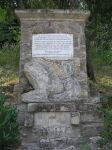Historical Monuments of Érd
There are seven monuments registered at the Hungarian National Office of Cultural Heritage in Érd. The Kutyavár (Dog Castle) is a 15th-century hunting lodge; the Minaret is from the 17th century, the Turkish Age; the 15th-century walls of the Roman Catholic Church were rebuilt in the 18th century; the Roman Catholic Parsonage is from the 17th-18th centuries; the baroque, 18th-century (1734) votive chapel was named after Saint Sebastian and Saint Rokus; the baroque Stone Cross is from 1789; the classicist buildings of the Hungarian Geographical Museum are from 1820-1840.

Kutyavár (Dog Castle)
If we turn from Balatoni Road to Kutyavári Road, we can find the oldest architectural monument in Érd, the ruins of a hunting lodge called Dog Castle. It was first mentioned in a charter in 1417.

Saint Michael Church
The manuscripts of the Capistrano monks working in Érd between 1718 and 1752 show that the apse and the walls of the nave of the Roman Catholic church, commended to the graces of Saint Michael, already stood in the 15th century.

Monument of Louis II
In 1926, on the 400th anniversary of the battle at Mohács, Nándor Baranyai town clerk and the leaders of the Jesuits in Érd, at the proposal of the Military Museum, erected a monument at the intersection of Római Street and Kastély Street, at the beginning of the road leading to the castle.
|

Minaret
In Érd-Ófalu, near the dam of the Danube, next to trace of the Roman military road (Mecset Street) stands the minaret of the 17th-century mosque, evoking the extinct memory of the Turkish Age.

Roman Catholic Parsonage
The ground floor of the baroque parsonage, a registered monument standing on Molnár Street, was built under the ownership of Péter Szapáry between 1685 and 1695. The parish was founded by Bosnian Capistrano grey friars after the Turks had been driven from the country.

Baroque stone crosses
Only one baroque stone cross is listed in the monument register of Érd. The one in the register, standing on a column with scrollwork in front of 1 Kinga Street, is a cross carved of stone.

Statue of Saint Walburga
We can admire the Statue of Saint Walburga, erected by János Illésházy around 1789, in Érd-Ófalu, in front of the buttress of the one-time castle.

The location and environment of the one-time Sina Castle
From the 13th century, we have data about who owned Érd. The exact date of the building of the castle is unknown; however, it is probable that a fortress stood in its location from the 13th century. The first mention of the “Stone Mansion” is from 1519, when it became the property of the Sárkány family of Ákosháza.
|